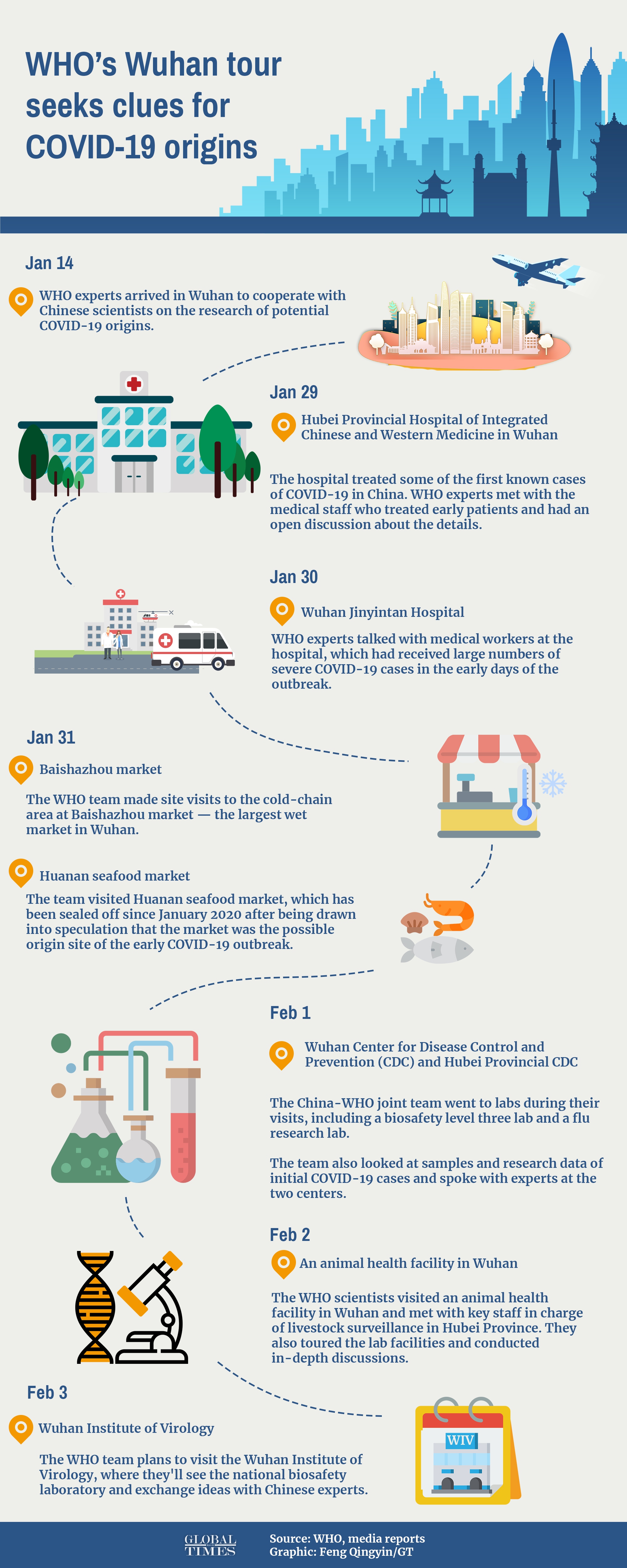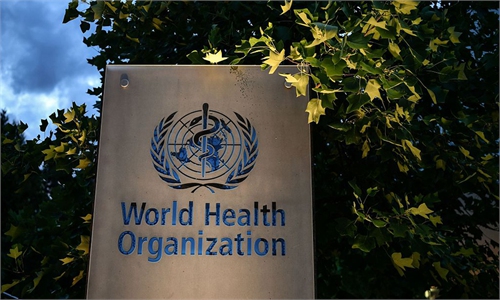WHO team to visit Wuhan virology institute Wednesday
Visiting WHO panel difficult to identify intermediate host: experts

Members of the World Health Organization (WHO) team, investigating the origins of the coronavirus, visit the closed Huanan Seafood wholesale market in Wuhan, Central China's Hubei Province on Sunday. Photo: AFP
Intensive field visits by the WHO expert team to Wuhan, Central China's Hubei Province continued, which will bring them to the Wuhan Institute of Virology on Wednesday after visiting a Wuhan animal health facility on Tuesday.
The team is scheduled to visit the Wuhan Institute of Virology Wednesday, Peter Ben Embarek, a scientist leading the WHO team, told the Global Times.
Ben Embarek told the Global Times previously that they would meet Shi Zhengli, a leading virologist from the Wuhan Institute of Virology, who was dubbed "Bat Woman" due to her years of research and achievements in research with bats and viruses.
While part of the ongoing field visits of 13 WHO experts to Wuhan is to seek clues on zoonotic source of COVID19, some Chinese experts said it's unlikely that the team could find the intermediate host of the original case, but some research by Chinese scientists could offer new hints for tracing the origins of the virus on a global scale.
Peter Daszak, a British zoologist and a member of the WHO team, shared in a post on social media on Tuesday that the experts met "with key staff in charge of livestock surveillance in Hubei Province," and toured laboratory facilities and held in-depth discussions on Tuesday when the team visited an animal health facility.
The facility turned out to be the Hubei Provincial Center for Animals Epidemic Prevention and Control, according to media reports, and the exchange between Chinese and foreign experts touched on the prevention and control of epidemic diseases from animals.
It was the fifth day of the field visits of the WHO team in Wuhan after their 14-day quarantine, on which China has offered help in coordinating resources and sharing the information, according to the team members and Chinese officials.
Since they completed quarantine on Thursday, they have visited two hospitals where the early cases in China were reported, a seafood market that was closely linked to the first batch of patients infected with the novel coronavirus in China, and provincial and municipal Centers for Disease Control and Prevention, and the animal health facility.
Visiting the animal facility as part of the fact-finding mission in China echoed a major focus of the WHO and other Chinese research on the possibility that the coronavirus may have jumped from animals to humans, which is widely considered as the most likely origin of the COVID-19.
"We've been seeing the virus being transmitted among humans and animals so far, and experts have been following these clues and exchange ideas in a professional way, and what we should do is cooperate with them," Zeng Guang, chief epidemiologist of the Chinese CDC, told the Global Times on Tuesday.
Ever since the first cluster of COVID-19 cases was detected in Wuhan, WHO has been looking for evidence of how the virus that has turned the world upside down originally made the jump from animals to humans, according to the organization.
While finding the zoonotic source of the virus and the route of introduction to the human population, in addition to immediate hosts is extremely important to provide a clear mandate, a predominant Chinese expert specializing in viral gene sequencing predicated that it would be like "searching for a needle in the ocean," for identifying the intermediate host in Wuhan, which may not be in the city or in China.
"If the intermediate host, let's say it's an animal, still exists in Wuhan or in China, Wuhan or China could have reported new domestic COVID-19 infections, which carry new viral gene types different from the current known gene types," the expert who spoke on condition of anonymity told the Global Times on Tuesday.
However, either Wuhan or other places in China has not found any new infections that freshen our knowledge of the already-known gene types, and the recent outbreaks across China all point to imported source of infections, the expert noted.
The novel coronavirus is able to have a genetic point mutation every two weeks. It is difficult to trace the real intermediate host and find out whether the virus originally made the jump from animals to humans, because numerous genetic mutations have already been spawned, he said.
Still, research from Chinese scientists, especially whom the WHO team met in Wuhan, may offer new understanding about the studies on origins. For example, Shi said in a recent article that mink could be a possible host of the origin of the virus.
Shi and his colleague Zhou Peng recently published an article titled "SARS-CoV-2 spillover events," in Science Magazine. The article said several groups reported SARS-related coronavirus in horseshoe bats in China and in pangolins smuggled from South Asian countries. But according to genome sequence comparison, none are directly the source of SARS-CoV-2, the agent of COVID-19.
In the meantime, COVID-19 infections in mink farms have been reported in eight countries, including the Netherlands, France, Italy and the US, according to the WHO.
There is limited evidence of animal-to-human transmission of SARS-CoV-2 except for mink, the study said.
"There are a number of possibilities about the intermediate hosts including bats, pangolins and mink. But what's most important for the WHO experts' field studies would be to gather as much information and data as possible for further analysis in a comprehensive way," Yang Zhanqiu, a virologist from Wuhan University, told the Global Times on Tuesday.
"It would also be helpful for the experts to explore more possibilities on the origin of the virus at the global scale," he said.
Chinese Foreign Ministry spokesperson Wang Wenbin also said on Tuesday that this trip of the WHO experts is part of the global science and research work on tracing the virus' origins, urging the US to also open up to this work given some COVID-19-related cases emerged earlier than the US CDC reported the first one.

WHO's Wuhan tour seeks clues for COVID-19 origins Infographic: Feng Qingyin/GT





